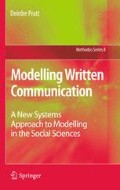Abstract
This chapter describes the schema of composing formulated in order to model composing processes for learner writers. The process had been largely intuitive in response to a pressing educational need, but had also been informed by intensive reading on the process approach to writing. At a formal level, it could be related to what Widdowson termed a “user’s model”, that is a description of language use from the point of view of the naïve user rather than one based on linguistic theory (Explorations in applied linguistics 2, 1984:9). Unravelling the modelling process from Franck’s perspective, almost at the other end of the investigation, revealed the user’s model to be an applied (or empirical) model of composing. It was, however, an applied model containing, implicitly, a system of communicative functions, which, in Franck’s terms, constitutes a theoretical model of composing. The user’s model is a key aspect of the modelling process documented here, the fulcrum, as it were, on which the rest of the process balances. The communicative functions could not have been identified clearly had it not been for the way in which they were separated in writing, much in the way that litmus paper reveals separate bands of elements in chemical compounds.
Access this chapter
Tax calculation will be finalised at checkout
Purchases are for personal use only
References
Bereiter, C. & Scardamalia, M. (1981) Does learning to write have to be so difficult? In C.N. Candlin (ed.) Learning to write: first language/second language. Essex: Longman.
Blakeslee, T.R. (1980) The right brain. Garden City, NY: Anchor Press/Doubleday.
Britton, J. (1981) Shaping at the point of utterance. In C.N. Candlin (ed.) Learning to write: first language/second language. Essex: Longman.
Candlin, C.N. (ed.) (1981) Learning to write: first language/second language. Essex: Longman.
Daiute, C.A. (1983) The computer as stylus and audience. College Composition and Communication 34(2):134–145.
de Callatäy, A. (2002) Computer simulation methods to model macroeconomics. In R. Franck (ed.) The explanatory power of models: bridging the gap between empirical and theoretical research in the social sciences. Norwell, MA: Kluwer Academic Publishers.
Emig, J. (1971) The composing processes of twelfth graders. Urbana, IL: National Council of Teachers of English.
Flower, L.S. & Hayes, J. (1981) A cognitive process theory of writing. College Composition and Communication 32:365–387.
Franck, R. (2002) The explanatory power of models: bridging the gap between empirical and theoretical research in the social sciences. Methodos Series, Vol. 1. Norwell, MA: Kluwer Academic Publishers.
Hairston, M. (1982) The winds of change: Thomas Kuhn and the revolution in the teaching of writing. College Composition and Communication 33(1):76–88.
Lindfors (1986) Writing to be read. Keynote address at the Language Development Conference, University of Natal, September 1986.
Lynn, S. (1987) Reading the writing process: toward a theory of current pedagogies. College English 49(8):902–910.
Marsh, G.E. (2003) Blended instruction: adapting conventional instruction for large classes. Online Journal of Distance Learning Administration, VI (IV) Winter 2003. http://www.westga.edu/~distance/ojdla/winter64/marsh64.htm (13 October 2004).
Mironesco, C. (2002) The role of models in comparative politics. In R. Franck (ed.) The explanatory power of models: bridging the gap between empirical and theoretical research in the social sciences. Norwell, MA: Kluwer Academic Publishers.
Nellhaus, T. (1996) Sub texts: or, the materiality of discourse – an alternative view. Paper delivered at the Rethinking Marxism Conference, Amherst, MA, 7 December 1996.
Pratt, D.D. (1987) A process approach: the formulation of a simplified conceptual framework showing the stages of the writing process, and an investigation into the effects on writing behaviour of communicating this framework directly to the learner. Unpublished masters dissertation, University of Natal, Durban, South Africa.
Pratt, D.D. (1990) The process approach to writing. In K. Chick (ed.) Searching for relevance. Durban: South African Applied Linguistics Association.
Pratt, D.D. (2005a) Social mechanism and software design: the use of a stochastic social-process algorithm in the design of a writing tutor program. Proceedings of the 3rd International Conference on Computer Science and its Applications (ICCSA-2005). San Diego, CA, USA, 27–30 June 2005:249–254.
Raimes, A. (1985) What unskilled ESL students do as they write: a classroom study of composing. TESOL Quarterly 19(2):229–256.
Rowley, K. (1998) Computational instructional design for construction of adaptive tutors in real time from distributed learning objects. Poster paper presented at ITS ’98. San Antonio, Texas. http://www.isrd.com/publications/conferences/ITS98/its98.htm (21 October 2004).
Shaughnessy, M.P. (1977) Errors and expectations. New York, NY: Oxford University Press.
Spack, R. (1984) Invention strategies and the ESL college composition student. TESOL Quarterly 18(4):649–670.
Widdowson, H.G. (1984) Explorations in applied linguistics 2. Oxford: Oxford University Press.
Zamel, V. (1985) Responding to student writing. TESOL Quarterly 19(1):79–101.
Szwed, J.F. (1981) The ethnography of literacy. In M.F. Whiteman (ed.) Writing: the nature, development, and teaching of written communication. Vol. 1: Variation in writing: functional and linguistic-cultural differences. Hillsdale, N.J.: Lawrence Erlbaum Associates.
Author information
Authors and Affiliations
Corresponding author
Copyright information
© 2010 Springer Science+Business Media B.V.
About this chapter
Cite this chapter
Pratt, D. (2010). The User’s Model of Composing. In: Modelling Written Communication. Methodos Series, vol 8. Springer, Dordrecht. https://doi.org/10.1007/978-90-481-9843-6_4
Download citation
DOI: https://doi.org/10.1007/978-90-481-9843-6_4
Published:
Publisher Name: Springer, Dordrecht
Print ISBN: 978-90-481-9842-9
Online ISBN: 978-90-481-9843-6
eBook Packages: Humanities, Social Sciences and LawSocial Sciences (R0)

